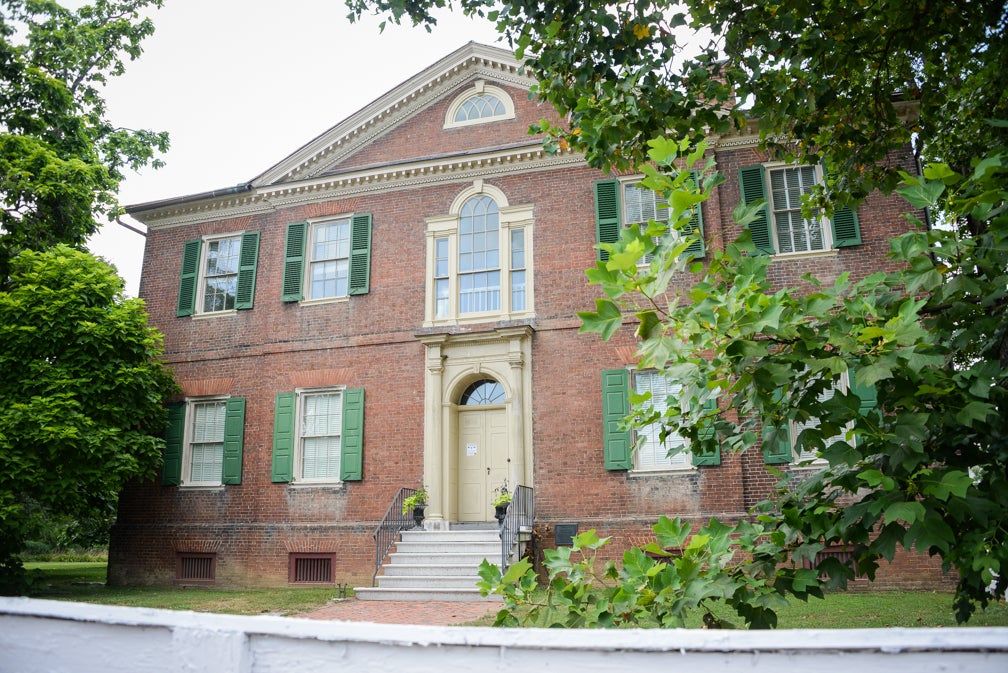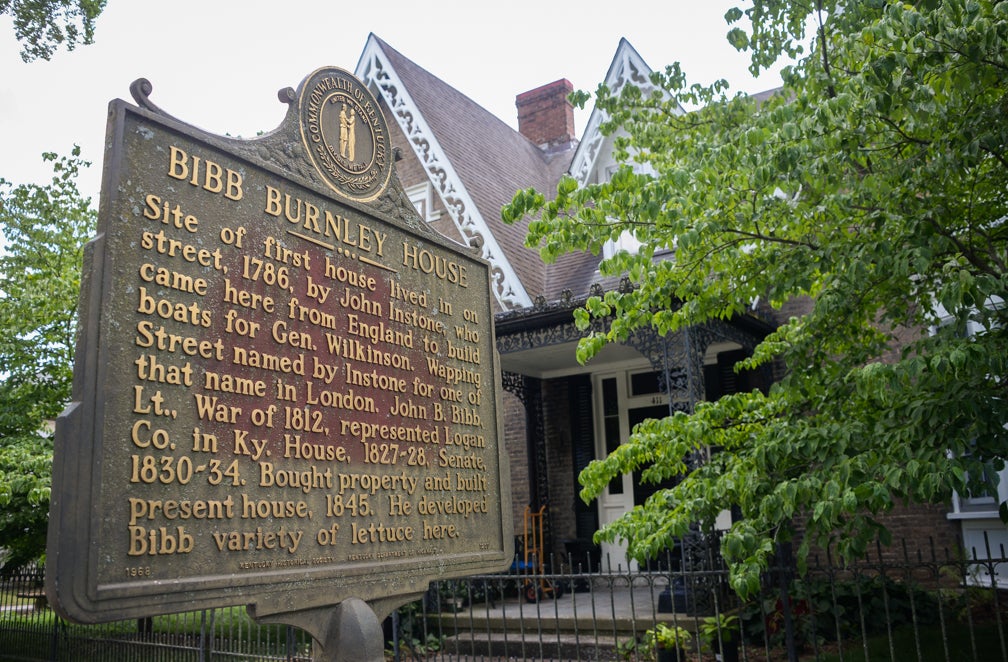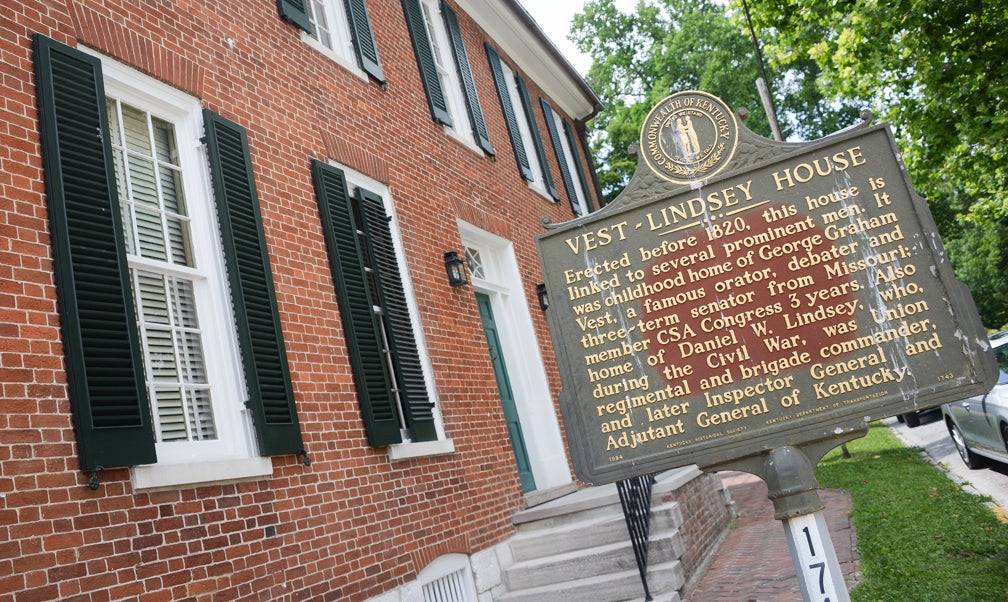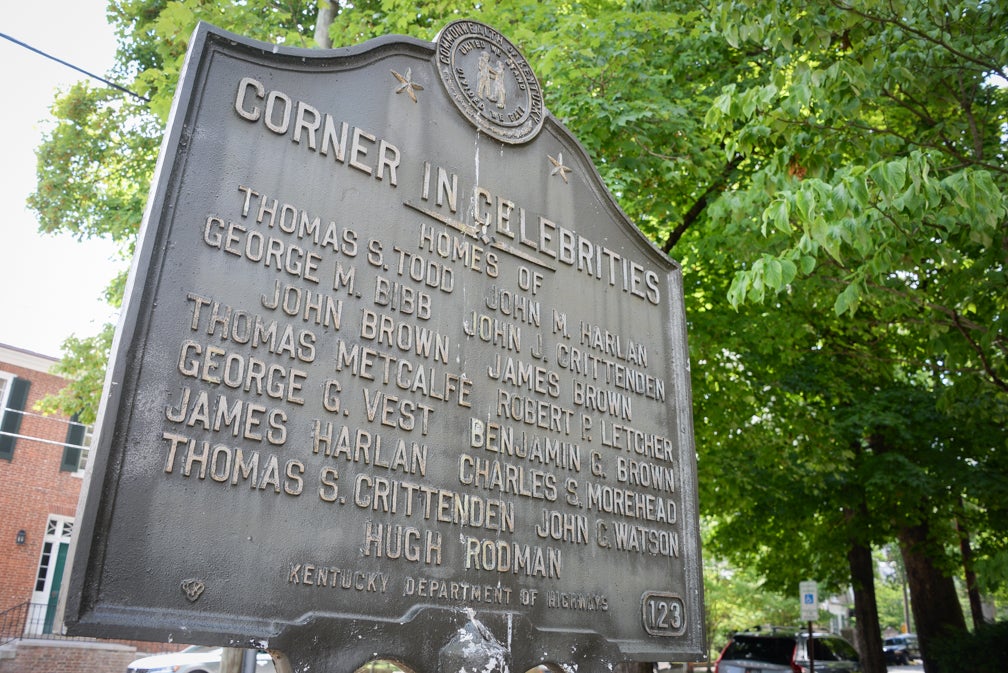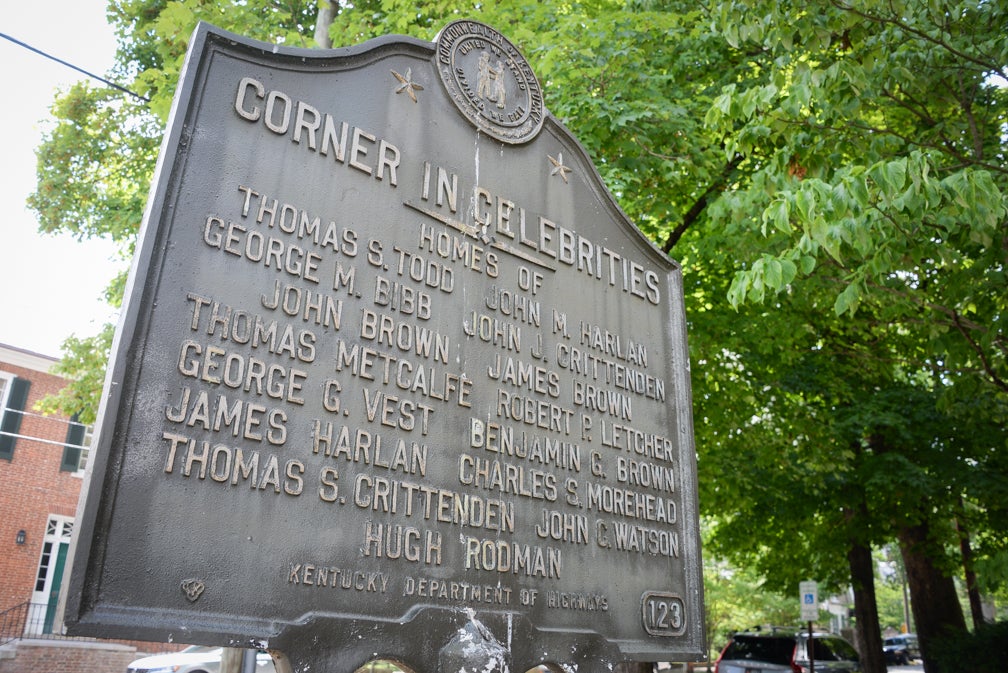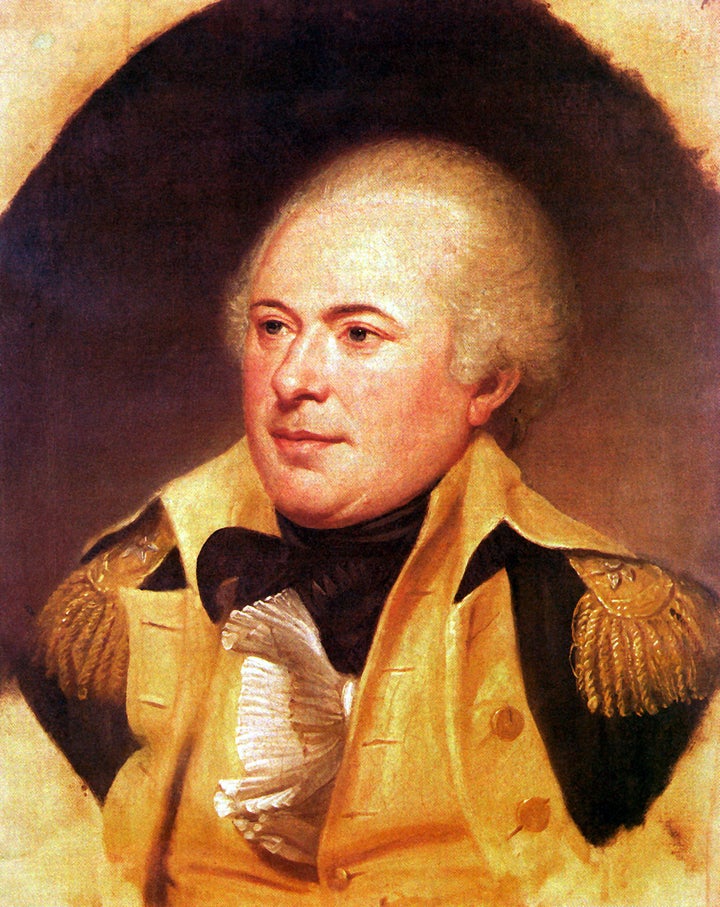By Charles H. Bogart
Located in the northwest corner of Washington and Wapping streets, next to the Women’s Club, is a Kentucky Historical Marker that proclaims this the “Corner in Celebrities.”
The names of 15 Frankfort citizens are listed on this historical marker. These natives of Frankfort were at one time known throughout the United States. The accomplishments of these individuals and how they helped shape the course of the United States is listed below:
• George M. Bibb (1776-1859) was born in Virginia and moved to Frankfort circa 1800. While in Frankfort, he was made Master of Hiram Lodge #4. He was elected to the Kentucky House of Representatives in 1806, 1810 and 1817. He was appointed to the Kentucky Court of Appeals in 1808 and to the position of chief justice in 1810. From 1811 to 1814, and from 1829 to 1835, he was elected to the U.S. Senate and, in 1844, was appointed United States Secretary of the Treasury. He is buried in the Frankfort Cemetery.
• Benjamin G. Brown (1826-1885) was born in Frankfort and studied at Transylvania College. He moved to Missouri in 1850 and served in the Missouri House of Representatives from 1852 to 1858. He was editor of Missouri Democrat and served as a colonel in the Union Army from 1861 to 1863. From 1863 to 1867, he was a member of the U.S. Senate and served as governor of Missouri from 1871 to 1873. He ran unsuccessfully for vice president of the United States with Horace Greely as the Presidential candidate. He is buried at Kirkland, Missouri.
• James Brown (1776-1835) was born in Virginia and moved to Kentucky circa 1790. He was Gov. Isaac Shelby’s secretary and, from 1792 to 1796, Kentucky Secretary of State. From 1796 to 1804, he practiced law in Frankfort. In 1804, he moved to New Orleans to serve as U.S. Attorney General of the Louisiana Territory. Then, from 1813 to 1817, he was U.S. Senator from Louisiana and, from 1824 to 1829, U.S. Minister to France. He, thereafter, settled in Philadelphia, Pennsylvania, entered into business, and is buried here.
• John Brown (1757-1837) was born in Virginia and was U.S. Representative from Virginia, 1789 to 1791. He introduced the bill in Congress to make Kentucky a state. From 1792 to 1805, he was U.S. Senator from Kentucky. In 1800, he moved to Frankfort and built Liberty Hall. He owned the ferry at Frankfort, was a director of the Frankfort Water Company and Bank of Kentucky, and helped found the Kentucky Historical Society. He was elected sheriff of Franklin County in 1835. He is buried in the Frankfort Cemetery.
• John J. Crittenden (1787-1863) was born in Versailles, Kentucky, but in adulthood lived in Frankfort. He served in the U.S. Senate from 1817 to 1819, 1835 to 1848, and 1855 to 1861. Between 1850 and 1853, he was U.S. Attorney General and, from 1861 to 1863, served in the U.S. House of Representatives. He was governor of Kentucky 1848 to 1850. He died in Frankfort and is buried in the Frankfort Cemetery.
• Thomas S. Crittenden (1819-1893) was born in Russellville, Kentucky. The son of Senator John J. Crittenden, he lived in Frankfort in the years before the Civil War. A lawyer, he was lieutenant colonel of the 3rd Kentucky during the Mexican American War and a major general in the Union Army during the Civil War, commanding XXI Corps. He retired from the Army in 1881 and is buried in the Frankfort Cemetery.
• James Harlan (1800-1863) was born in Mercer County, Kentucky, and spent most of his life living in Frankfort. From 1829 to 1935, he was commonwealth attorney; 1835 to 1839, a member of the U.S. House of Representatives; 1840 to 1844, Kentucky Secretary of State; 1845 to 1849, a member of the Kentucky House of Representatives; 1850 to 1859, attorney general of Kentucky; and 1861 to 1863, U.S. attorney for Kentucky. He is buried in the Frankfort Cemetery.
• John M. Harlan (1833-1911) was born in Boyle County, Kentucky, but his family moved to Frankfort. Of a slaveholding family, in 1862, he raised the 10th Kentucky Infantry for the Union. In 1863, he was elected Kentucky attorney general and helped man Fort Boone during the Confederate attack on Frankfort in June 1864. Appointed to the U.S. Supreme Court in 1871, he served until 1911. His most famous opinions center around the 1883 Civil Rights Case and the 1896 Plessy vs. Ferguson. He is considered to be one of the giants in Supreme Court case law. He is buried in Washington, D.C.
• Thomas Metcalf (1780-1855) was born in Virginia, however, the family moved to the Lexington area in 1784. He was elected to the Kentucky House in 1811. During the War of 1812, he was a lieutenant in the Kentucky Militia, participating in the Defense of Fort Meigs. He served in the U.S. House of Representatives from 1819-1828, as governor from 1828 to 1832, and as U.S. senator from 1848-1849. A stonemason by trade, he helped build the Old Governor’s Mansion. He is buried in Nicholas County.
• Charles S. Morehead (1802-1868) was born in Nelson County, Kentucky. He was elected to the Kentucky House in 1828 and became Kentucky’s attorney general in 1832. During the 1840s, he served in the Kentucky House and the U.S. House of Representatives. In 1855, he was elected governor, running as a “know-nothing.” His rhetoric led to the Bloody Monday Riot in Louisville. During the Civil War, while living in Louisville, he espoused the Confederate cause. Arrested and placed in military prison, upon release, he moved to Canada and then Mississippi. He is buried in the Frankfort Cemetery.
• Hugh Rodman (1859-1940) was born in Frankfort and graduated from the U.S. Naval Academy in 1880. He saw service during the Spanish American War on board the cruiser USS Raleigh at Manila Bay. In 1917, as a rear admiral, he commanded the United States Navy’s battleship squadron attached to the Royal Navy. From 1919 to 1921, he commanded the U.S. Navy’s Pacific Fleet. He is the author of the book “Yarns of a Kentucky Admiral” and is buried in Arlington Cemetery.
• Thomas S. Todd (1765-1826) was born in Virginia and moved to Kentucky in 1787. He served as clerk to the five constitutional conventions held between 1784 and 1792. Once Kentucky became a state, he served as secretary to the Kentucky legislature. Appointed to the Kentucky Court of Appeals in 1801, he was made chief justice in 1806. From 1807 to 1826, he was a member of the United States Supreme Court. He married Lucy Payne Washington, youngest sister of Dolly Madison, in a White House wedding in 1812. He is buried in the Frankfort Cemetery.
• George G. Vest (1830-1904) was born in Frankfort. A graduate of Transylvania and Center College, in 1853, he moved to Missouri. He would serve Missouri as a senator in the Confederate Congress. Then, from 1879 to 1903, he was elected by Missouri to serve in the U.S. Senate. His main achievement as a senator was preserving Yellowstone as an undeveloped National Park. He is best known for winning in court a judgement for the owner of Old Dunn who had been shot by a neighbor. This court case added the phrase “A dog is a man’s best friend” to the American vocabulary. He is buried at Sweet Springs, Missouri.
• John C. Watson (1842-1923) was born in Frankfort and graduated from the U.S. Naval Academy in 1860. He saw action during the Civil War at the Battle of Mobile Bay, where he was flag lieutenant to Admiral David Farragut. During the Spanish American War, as a commodore, he flew his flag from the mast of the USS Oregon during the Battle of Santiago, Cuba. In 1899, he commanded the U.S. Navy’s Asiatic Fleet. In 1902, he represented the U.S. government at the coronation of Edward VII. He retired from the Navy in 1904 and is buried in Arlington Cemetery.
